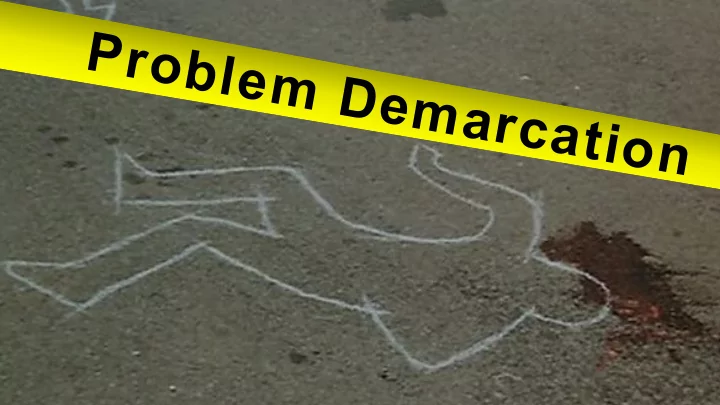

Problem Demarcation
Why “problem demarcation” ? Best serve your client’s interest 1. Establish what is your client’s real problem
Why “problem demarcation” ? Best serve your client’s interest 1. Establish what is your client’s real problem Be efficient 2. Look only into issues that matter In adequate detail
Why “problem demarcation” ? Best serve your client’s interest 1. Establish what is your client’s real problem Be efficient 2. Look only into issues that matter In adequate detail Be accountable for your findings 3. Make clear what you decide to ignore Reflect on how this limits your conclusions
Why “problem demarcation” ? Best serve your client’s interest 1. Establish what is your client’s real problem Be efficient 2. Look only into issues that matter In adequate detail Be accountable for your findings 3. Make clear what you decide to ignore Reflect on how this limits your conclusions
Problem demarcation How to proceed? 1. Starting point 2. Means-ends analysis 3. Several problem statements 4. Objectives trees + System boundaries 5. Compare & Choose
1. Choose one issue as a starting point
1. Choose one issue as a starting point Reduce CO 2 emissions Increase capacity of Deepen container stack harbor
2. Perform a means-ends analysis “means-ends box” Reduce ¡ ¡ CO 2 ¡emissions ¡ a single verb phrase
Why? Reduce ¡ ¡ CO 2 ¡emissions ¡ How?
H S Why?
H Why? S
F Why? (and so on) H S
How? F H S
How? H S
How? S
How? S
How? S
S How? (and so on...)
“means-ends diagram”
problem 1 problem 2 problem 3 , 4 , 5 problem 6
3. Problem statements for several “focal means/ ends” means-ends diagram: A “focal objective” Y ¡ X A A undesirable side effects B B C C D D of means E F G H I C D B mean J K L s problem statement: (1) “How can the client achieve A without (too much) X or Y ?”
means-ends diagram: B “focal objective” Z ¡ X A undesirable side effects B B C D of means E E F F G H I F E mean J K L s problem statement: (2) “How can the client achieve B without (too much) X or Z ?”
means-ends diagram: A B C C D E F G G H H I undesirable side effects J K L of means G and H (3) “How can the client achieve C without (too much) ... ?”
means-ends diagram: A B C D D E F G H I H I undesirable side effects J K L of means H and I (4) “How can the client achieve D without (too much) ... ?”
means-ends diagram: G “focal objective” V ¡ U A undesirable X side effects B C D of means E F G G H I J K L mean J J K K L L s problem statement: (5) “How can the client achieve G without (too much) U, X or V ?”
3. Problem statements for several “focal means/ ends” means-ends diagram: (1) “How can the client achieve A without (too much) X or Y ?” A B C D (2) “How can the client achieve B without (too much) X or Z ?” E F G H I (5) “How can the client achieve G without (too much) U , X or V ?” J K L
4. Problem statement → o bjectives tree (1) “How can the client achieve A without (too much) X or Y ?” good A A X < 5 M € little X little Y y 1 = 0 y 2 < 10 -6 a 1 < 0.1 a 2 > 100
4. Objectives tree → system diagram a 1 ¡ a 2 ¡ good A X ¡ A X < 5 M € little Y y 1 ¡ a 1 < 0.1 a 2 > 100 y 1 = 0 y 2 < 10 -6 y 2 ¡ criteria objectives tree
4. Add means to system diagram a 1 ¡ B a 2 ¡ A A X ¡ C B B C C D D y 1 ¡ E F G H I J K L D y 2 ¡ criteria means-ends diagram means
5. Choose one problem + associated system a 1 (1) ¡“How ¡can ¡the ¡client ¡achieve ¡ A ¡ ¡ B a 2 ¡ ¡ ¡ ¡ ¡ ¡ ¡ ¡without ¡(too ¡much) ¡ X ¡or ¡ Y ¡?” ¡ X C y 1 D y 2 b 1 (2) ¡“How ¡can ¡the ¡client ¡achieve ¡ B ¡ ¡ E b 2 ¡ ¡ ¡ ¡ ¡ ¡ ¡ ¡without ¡(too ¡much) ¡ Y ¡or ¡ Z ¡?” ¡ y 1 y 2 F Z (5) ¡“How ¡can ¡the ¡client ¡achieve ¡ G ¡ ¡ g 1 J g 2 ¡ ¡ ¡ ¡ ¡ ¡ ¡ ¡without ¡(too ¡much) ¡ U , ¡ V ¡or ¡ W ¡?” ¡ U K V L W
Problem demarcation How to proceed? 1. Starting point 2. Means-ends analysis 3. Several problem statements 4. Objectives trees + System boundaries 5. Compare & Choose Involve ¡your ¡client ¡in ¡this ¡process! ¡
Recommend
More recommend